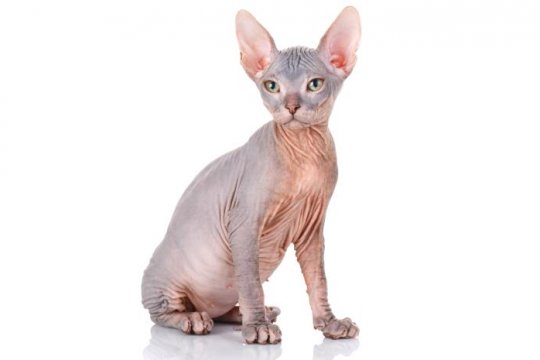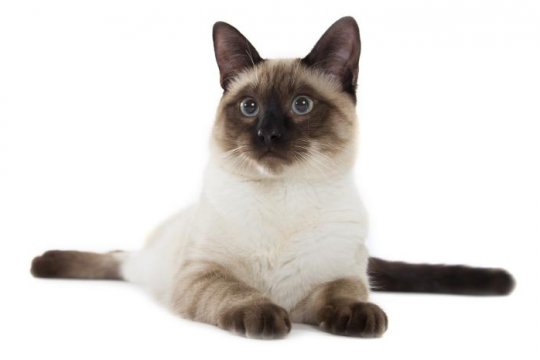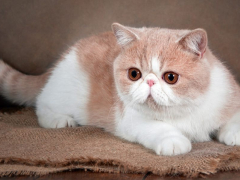Personality and Temperament
With its soft, silky, short coat in silvery blue-gray, the Russian Blue cat is stunning to behold, but this breed is also a marvelous companion. Affectionate and loyal, Russian Blues happily accompany their family members around the house, though they can be shy when strangers visit.
The Russian Blue isn't much of a mischief maker. Like any breed, these cats might get into things during their kitten years, but once you've gently taught them which surfaces are theirs to sit on and which should be left alone, the Russian Blue will generally stick to approved areas.
Russian Blue cats are highly intelligent and capable of learning many tasks, such as playing fetch, coming when called, and more. Many also learn to open doors—something to keep in mind when trying to keep a cat out of a certain room or cupboard! Because they can be shy and reserved, Russian Blue cats do not typically take to leash training. They are far happier sticking to known quantities and spending time with their families.
If you bring a Russian Blue into your home, you'll have a steadfast companion with a fondness for daily routines and gentle cuddles, along with a fairly strong opinion about everything that takes place in the household. While their families are away at work, these cats will happily nap instead of looking for ways to get into trouble. They do learn to get along with other pets and they can appreciate respectful children, but they don't need constant companionship.
Beautiful, fairly self-sufficient, and friendly with people they come to trust, Russian Blues make well-rounded pets and fit easily into a variety of living situations.


Care
Nutrition
Grooming
Exercise
Health
The Russian Blue has no special nutritional needs. However, high-quality diet is important for the health of all cats. Fresh food is an excellent choice and high-protein, low-carbohydrate commercial foods that incorporate real fish or real meat as the main ingredient are preferable to high-carbohydrate diets that can contribute to obesity.
Thanks to its short, easy-care coat, the Russian Blue cat doesn't require much help in the grooming department. These cats benefit from a weekly brushing, which helps remove loose hair and cuts back on shedding.
Brushing your cat's teeth daily with a pet-safe toothpaste and toothbrush is the best way to prevent dental disease, and regular nail trimming will keep the nails in good condition.
Even though Russian Blue cats are renowned for their dignified nature, they do have a playful streak. These cats have plenty of fun with toys they can enjoy on their own as well as interactive toys like feathered wands and lasers. In addition, they appreciate a multilevel cat tower, particularly if it has compartments for sleeping and hiding. Scratching posts are essential as well.
Since the Russian Blue is a naturally occurring breed, most Russian Blues enjoy good health. These cats can be prone to some of the same feline diseases that affect other cats, including hypertrophic cardiomyopathy, kidney disease, obesity, and periodontal disease.
History
With its incredible silvery-gray coloration, you might think that the Russian Blue cat was carefully developed by feline geneticists, but the truth is, this is a naturally occurring breed. Believed to originate in Russia's Archangel Isles around the port of Arkhangelsk, these cats probably accompanied sailors to Northern Europe and Great Britain during the 1860s. The first Archangel Cat was shown at London's Crystal Palace in 1875 and ever since then, these amazing cats have been highly coveted.
The Russian Blue was shown alongside all other blue cats until it was given its own show class in 1912. Following the second world war, the Russian Blue experienced a population collapse as so many cat breeds did at that time. Breeders, mostly in Scandinavia and England, worked to bring numbers back up.
Once these cats reached the shores of the United States, breeders allowed British Russian Blue and Scandinavian Russian Blue cat bloodlines to mingle. At the same time, Russian Blue cats have contributed to the creation of other breeds including the Nebelung, which is sometimes called the long-haired Russian Blue. The Havana Brown was also developed with the help of Russian Blues, and some Oriental Shorthairs carry Russian Blue DNA as well.
Russian Blue cats are recognized by cat breed associations all over the world, including the Cat Fanciers' Association (CFA) and The International Cat Association (TICA).


Eyes
Legs & Paws
Tail
The Breed Standard
Body
Head
Ears
Coat
Color
Frequently Asked Questions
How much does a Russian Blue cat cost?
Russian Blue cats cost between $1,000 and $2,500.
How big do Russian Blue cats get?
Russian Blue cats tend to be medium in size. A fully grown Russian Blue cat might weigh between 8 to 15 pounds or more, and range in height anywhere from about 8 inches to 10 inches tall.
How long do Russian Blue cats live?
The average life span for a Russian Blue is 15 to 20 years.
Do Russian Blue cats shed?
Russian Blue are short-haired cats. The coat is very thick and dense, but does not shed as much as some other cat breeds.























Hi everyone ☺ where i live theres 3 cats i didn’t know what they were untill now there fancy. I wasn’t really a cat person but know there so adorable to me and cute .I accendently almost broke one of cats rib cage by smashing the glass sliding door on his stomach i feel so bad I pet him and ask tell him sorry but he doesn’t understand I guess I whant to take him to the clinic but I can’t right I wish I could get x rays .
Oh, Brenda, I’m so sorry this happened. Don’t beat yourself up over it, but please do try to get him to the vet if possible. You may also be able to call a vet and describe what happened as well as how he seems to be affected, which could help you to get some insights into whether or not veterinary attention is necessary. Wishing you all the best.
I have a Blue Cat; her name is Bella. She gets very anxious some time and will go hide from us. After her first year she began to give off this really bad odor at certain times. This scent is driving me crazy! My living room smells terrible, and my sofa is ruined. What can I do to get rid of the odor? We are moving at the end of the year, and I want to keep her but that odor has to go.
I know this is a bit of an odd question, but are you sure that Bella is a female? Strong odors are generally associated with intact male cats, so I have to ask. Other than that, the “bad odor” is a very vague issue—is it coming from her mouth or does she seem to be secreting something from her skin? Is it coming from her litter box? Could it be coming from her anal glands? I would take a few more notes and think about what you’re noticing and then bring those observations to a veterinarian. They may be able to help you figure the problem out. You may also find it helpful to post about this situation in the All About Cats community, where you can continue an ongoing conversation with our forum members and veterinarian moderators.
My neighbor and I are fostering a Stray male Russian Blue that has been neutered. He has a clipped Right Ear. We have let him be the guide for socialization skills. We have been working with him for 12 months. He does on occasion have a pungent odor which we attribute to anal glands. He smart affectionate and gets along with other cats and dogs. He loves sleeping inside during the day but needs to be outside at night. He is so that he comes in when the weather is bad. They make great pets and can help train other friendly cats.
Is he adoptable
My vet says my cat is a domestic shorthair, but my family and I think my cat is a Russian blue. I mean he looks like one, this entire article is just like him.
Please say if you think the vet is right with our cat I would appreciate it ,Thanks.
Hi Mae, your vet probably says that because no cat can officially “be” a member of a breed without papers. However, there is a chance that your cat is, indeed, a Russian Blue. Currently, cat DNA testing is not as effective or reliable as dog DNA tests, but you may have some luck with Wisdom Panel.
I have a Russian Blue with polydactyl claws. HIs coat of fur is very dark grey, almost black and all the Russian Blue cats on-line are pale blue grey in color. Why is he so different in color? I was thinking that Russian Blue cats were a rare breed of cat. It had been nearly 50 years ago that I had seen a Russian Blue cat up close and touching it. He is a very handsome cat, but very strange. He loves to stare alot and jump walls at night. He will not greet us. He is so different from our previous cats that we used to own. One bad thing is that I can not retrieve his medical record from his previous owners, so I do not have a shot record nor medical record on him. I not sure too many vets would be willing to treat him. He is very sweet and gentle, even though he has huge paws.
Hello Debra, thanks for commenting! Your Russian Blue sounds charmingly eccentric. As for the reason why his coat is so dark grey, that’s a tough question! Some Russian Blues do have a deep slate-colored coat, so yours may just be one of those. As long as you have confirmed that he is a Russian Blue from his breeder and have the paperwork confirming it, I would just assume that his coat is on the darker end of the normal spectrum.
Hi Mallory: Unfortunately, I have no information on Zeke, the Russian Blue. His previous, temporary residency was with my husband’s boss, who was unable to retrieve the medical records, shot record nor was their registered paperwork confirming that he is a Russian Blue. But my husband’s boss just said by word of mouth from two previous owners of the cat. He is just a beautiful and nice acting cat. It was said that the original owner took good care of him. I wonder if DNA testing could confirm that Zeke is a Russian Blue cat. That would be nice. I also know that the cat came from Seattle, WA to Kalispell, MT and that he was owned by a teacher that could not keep him due to her living situation. Funny, that his name was originally Roosevelt and former president Teddy Roosevelt had a polydactyl cat in the Whitehouse. Would a DNA test help us find out a few more things about the cat? Sincerely, Debra Tharp
Hi Debra, cat DNA testing is generally not quite as reliable as DNA testing for dogs due to the relative lack of selective breeding over the years, but Basepaws or Wisdom Panel testing might shed some light on your cat’s genetic makeup. Hope this helps!
Russian Blue cats do not come in polydactyl.
Ah, that’s a good clarification. While polydactyly can affect cats of any breed, the breed standard for the Russian Blue features five toes in front and four on the rear paws. I’m sorry I didn’t realize this when I responded to Debra earlier.
“Zeke” is his name. Named after my husband’s favorite book in the Bible “Ezekiel”. We just love him. He is an excellent cat to own.
My cat, Shadow is kinda “fat” we are very aware of what he has been eating ,I am a little afraid that he will become too big and will have a lower lifespan.
cats r best 🙂
Hi Mallory,
I like your You tube Videos, quite helpful. I am very excited as I will be getting my first Cat (A Russian Blue) from a Breeder in the beginning of December. I have Boarded Cats Before but never owned One. I Selected this Breed specifically because of what I have read and Heard. The Low Shedding and being mostly Hypoallergenic appealed to me as is the color of the Coat and those Beautiful Emerald Eyes not to mention that cute face and a look that the cat is smiling. Thanks for the Reviews on Wet Food and Litter. it has helped a lot.
Thanks for your support, Mike! These are exciting times, and I hope our content continues to be a resource for you as you discover what it’s like caring for a Russian Blue of your own.
I’m interested in adopting one I saw today… he was so handsome! He’s an adult and is already spayed, I was wondering if he’ll get along with my kids (3 & 6) and my senior yorkie/chihuahua mix. My dog is the type that will bark at the wind and she doesn’t care for other animals, she only really likes humans but won’t “attack” another animal she just won’t socialize with them. Do you think this would be a problem with a Blue Russian?
It really depends on how they’ve been socialized prior to adoption and after, but I’ve certainly heard of Russian Blue cats who get along wonderfully with dogs. They tend to be quite calm and friendly, so I think it could be a good fit.
After a 30 year wait, I bought a Russian Blue kitten from a ‘reputable’ breeder when he was 3 months old last spring. He is a wonderful companion and a ton of fun. It took him only part of one play session to figure out the laser light emanated from a small flashlight. The next night, he stomped around till I picked it up. Then, he promptly ran out to wait for it, looking at my hand! So yes, smart.
Originally I had read that they were ‘silent’ cats. Not true and no longer stated. He meows a bit and trills a lot! Yes, he loves to play when he is up. He loves water! Jumped into a full bath three times in the first week! Now he watches and worries when I get into the tub and stands guard on the mat I will step on when I get out. He learned to come when called and sit on command by the age of 5 months. Yes, I use a clicker for training and food treats for rewards
I’m trying to convert him to raw food, but it will take a while. Currently we are at the raw freeze dried treat stage. He does love those as payment for doing a trick! I think that I may have to go to cooked real food as an intermediate step, then move to raw. Fortunately, he loves beef, ham, and cooked chicken which he has been given over the last few weeks as a tiny treat in his saucer. Currently he eats grain free kibble and canned food.
I have owned a Tonkinese and Siamese in the past and loved them both very much. But I think that this guy is the best one for an aging Mom who waited a very long time for him. <3
Thanks for all your info and suggestions Mallory!
Thanks for sharing!
10/10, would recommend. My cat, Misty, is a Russian Blue/DSH mix and she’s awesome. She wasn’t originally mine, as she was my sister’s, but she chose me as her human and my sister let me keep her when she moved out of state.
Misty is a very well behaved cat and will learn really quick when instructed as to what isn’t acceptable or what is. An example of this is after moving in with my current roommates, she jumped on one of their keyboard instruments and was promptly moved off and told not to jump up there. She hasn’t done it since.
I do appreciate her for her want to be close to me when I’m at home because it really helps when life gets rough. Though, I always wish I could do more for her for being such a good companion.
She’s about thirteen to fourteen at this point and in pretty good health, so I’m hoping she’ll make it to her late teens or maybe even twenty. I will likely get another Russian Blue after she passes because they are just the best.
this cat is so cute, i have a mix breed of this cat and a different one. we are still trying to find out what the other breed is.